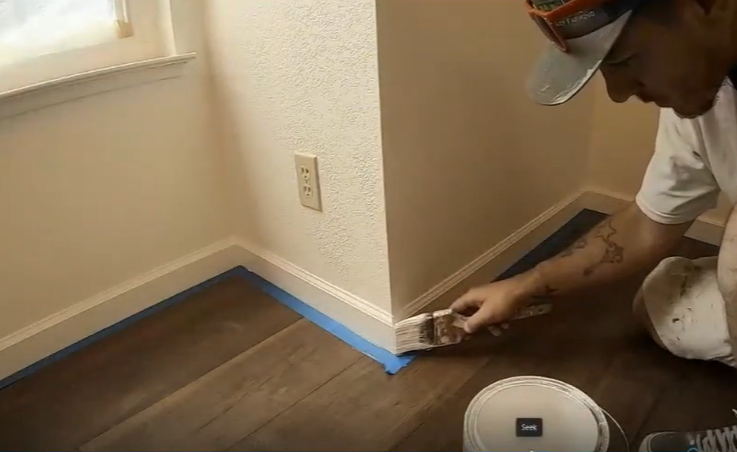Learn 10 proven technique how to eliminate brush strokes when painting. Achieve a smooth finish with these expert techniques for flawless artwork. Creating a smooth, flawless paint finish can transform a simple project into a professional-looking masterpiece. Whether you’re working on walls, furniture, or small decorative pieces, brush strokes can sometimes disrupt the clean, polished appearance you’re aiming for. Thankfully, with a few strategic techniques, you can get rid of brush strokes, achieving a perfectly smooth surface. This guide will walk you through the essential tips and tricks, from choosing the right tools to mastering application techniques, so you can tackle your next painting project with confidence and precision. Read on to discover how to achieve that seamless, stroke-free finish!
1. Use the Right Brush
Brush Shape & Size:
- Flat Brushes: These brushes are great for covering large, flat areas of your canvas evenly. The broad, rectangular shape minimizes the number of strokes needed, reducing the appearance of brush marks. A large flat brush is especially effective for base layers or underpainting.
- Tip: For acrylics and oil paints, use a flat brush for blocking in large areas with smooth, controlled strokes.
- For watercolors, flat brushes help with washes, but they tend to leave more visible texture, so ensure you’re using them with a light touch.
- Round Brushes: These are excellent for detail work, especially for blending or fine lines. The pointy tip allows you to control strokes with precision, and the shape helps to smooth areas out.
- Tip: For watercolors, round brushes are essential for detailed work and soft washes.
- Filbert Brushes: Filberts have a slightly rounded, oval shape. They’re versatile brushes that combine the benefits of both round and flat brushes, allowing for both detail and soft blending.
- Tip: Filberts are great for softening edges and creating smooth transitions, making them ideal for reducing brush strokes in oil painting.
Brush Quality:
- Synthetic Brushes: They are durable and have a fine, controlled shape, making them great for acrylics because they can maintain their shape even with the rapid drying times of acrylic paint. However, some lower-quality synthetics can leave streaks if not used with proper technique.
- Tip: Good synthetic brushes have excellent spring and are stiff enough to push through thick acrylic paint without damaging the surface.
- Natural Brushes: Brushes made from animal hairs, such as sable or hog bristle, are great for oil and watercolor painting. They hold more paint, making it easier to apply smooth, even strokes.
- Hog bristle brushes are stiff and excellent for thick oils, while sable is soft and ideal for fine detail work.
- Tip: If you want to achieve a smooth finish in oil paints, a softer sable brush allows for better blending, while hog bristles are perfect for rougher, textured areas.
2. Proper Paint Consistency
Thinning Paint:
- The consistency of your paint directly influences how smooth it will apply. Too thick of a paint can drag, causing brush marks.
- For Acrylics: If your acrylic paint is too thick, you can thin it by adding water (in small increments) or use acrylic mediums (like slow-drying mediums or gloss gels) to help smooth out the paint.
- For Oils: Use a solvent like turpentine or mineral spirits to thin oil paints. You can also mix mediums such as linseed oil, stand oil, or liquin to get a smoother consistency that is easier to apply.
- Avoiding Over-Thinning: It’s important not to over-thin your paint, as that can make it too watery and less pigmented. Thin the paint just enough to make it flow smoothly.
Workability:
- Acrylic Paints: Acrylics dry very fast, making it challenging to blend smoothly. To slow the drying process and give yourself more time to smooth out brush strokes, use a retarder medium. Retarders prevent the paint from drying out too quickly, allowing for better blending and a more even finish.
- Tip: Mix a small amount of retarder directly into your acrylics; be mindful that adding too much retarder can alter the paint’s consistency, so test it out first.
- Oil Paints: One of the benefits of oil paints is their slower drying time, which gives you more time to manipulate the paint and smooth out brush strokes. You can also use mediums (like linseed oil or Liquin), which help the paint remain workable for a longer period, thus reducing streaks and allowing you to blend more easily.
3. Layering and Glazing
Thin Layers:
- Why Thin Layers Work: Thin layers help prevent the buildup of visible brush strokes, as each layer is allowed to dry before you apply the next. This ensures that you maintain control over the texture and surface without disturbing earlier work.
- For oil paints, thin layers are crucial because oils take time to dry, and applying thick layers can lead to an uneven finish.
- Acrylics: Since they dry quickly, layering thin layers of paint allows you to correct mistakes without disturbing earlier work.
- Tip: Thin your paint slightly before applying each layer to prevent heavy brush marks.
Glazing:
- What Is Glazing? Glazing is a technique often used in oil painting where you apply a thin, transparent layer of paint over a fully dry layer. This adds depth, vibrancy, and a smooth, even finish. A glaze can help soften brush strokes and hide imperfections.
- How to Glaze: Mix your oil paint with a medium like linseed oil or Liquin to create a transparent wash. Apply it over a dry underlayer using a soft brush. Don’t apply too much at once; thin, multiple glazes build up smooth layers.
- Tip: Glazing also creates a luminous effect and is great for softening hard edges.
4. Use a Smooth Surface
Canvas Preparation:
- A smoother surface gives you better control over the brushwork, reducing texture that can create visible strokes.
- For Acrylics & Oils: Use a smooth canvas board or smooth primed linen canvas. Apply a gesso layer to the canvas, and then sand the gesso lightly with fine sandpaper to achieve a smooth surface.
- Tip: You can also buy pre-primed smooth canvas boards for a more professional finish, especially when aiming for a smooth, brushstroke-free look.
Watercolor Paper:
- The texture of watercolor paper is particularly important. Hot-pressed paper has a very smooth surface, which is perfect for avoiding brush strokes, especially when you want to achieve seamless washes.
- Cold-pressed paper has more texture, which can cause brush strokes to be more visible.
- Tip: If you need smoother watercolor applications, always go for hot-press paper for a smoother result.
5. Paint Application Techniques
Feathering:
- Feathering involves making very light, long, and controlled brush strokes to gradually soften the edges of your paint. The technique uses gentle pressure, which allows you to blend paint and reduce visible brush marks.
- Tip: Feather the edges of a color transition to achieve a soft gradient, especially in areas like the sky or water.
Cross-Hatching & Scumbling:
- Cross-Hatching: In this technique, you apply thin layers of paint in criss-cross strokes. The layers build up a smooth effect without heavy brush marks.
- Tip: Use a small flat or filbert brush to apply cross-hatched layers of color over one another.
- Scumbling: In oil painting, scumbling involves rubbing a thin layer of lighter-colored paint over a dry, darker layer. This softens the brush strokes and creates a smooth transition between colors. It’s great for blending edges and giving a hazy, smooth effect.
- Tip: Make sure the underlayer is completely dry before scumbling to avoid disturbing the paint beneath.
Blending:
- Blending is the act of smoothing out areas of paint so that no distinct brush strokes are visible. For oil paints, this is often done using a soft blending brush or even a fan brush, gently working the edges of two painted areas together.
- Tip: With acrylics, work quickly before the paint dries. Use a clean, dry brush or a wet sponge to blend the paints seamlessly.
6. Use a Roller or Airbrush (Optional)
Rollers:
- Rollers are particularly useful for covering large areas with a smooth coat of paint. Foam rollers, in particular, are excellent for achieving an even finish without visible strokes. This works particularly well with acrylics.
- Tip: Use a very smooth roller for best results. Practice rolling the paint out evenly across the canvas to avoid streaking.
Airbrush:
- An airbrush sprays paint in a fine mist, which eliminates brush strokes entirely. Airbrushing is great for smooth gradients, soft textures, and uniform color application.
- Tip: For acrylics or watercolors, you can use an airbrush to create seamless applications. It’s especially useful for creating backgrounds or delicate transitions.
7. Dry Brushing (When Appropriate)
Dry Brushing:
- Dry brushing involves using a brush with very little paint on it and a dry or nearly-dry canvas. The technique is great for adding texture or highlighting areas without disturbing the paint underneath.
- Tip: If you want to avoid brush strokes, ensure you apply dry brush techniques to areas where texture is acceptable, like highlights or faded details.
8. Work in a Well-Ventilated Area
Control Drying Times:
- A well-ventilated area helps manage drying times for oils and acrylics. For acrylics, this prevents the paint from drying too fast, which can cause streaks. For oil paints, it allows for more time to blend and smooth out the surface.
9. Final Finishing Techniques
Sanding (For Oils):
- After your oil painting has dried completely (several days or weeks), you can gently sand the surface to remove rough textures and visible brush strokes. Use fine-grit sandpaper (around 400-600 grit) for this process.
- Tip: Be cautious when sanding, as you don’t want to damage the surface or paint layer.
Varnish (For Acrylics and Oils):
- Once your painting is completely dry, apply a glossy or satin varnish to smooth out imperfections and give your painting a unified sheen.
- Tip: Use a soft brush or spray varnish to avoid disturbing the surface.
10. Practice Patience
- Always allow sufficient time for your paint layers to dry before applying new layers. Rushing can lead to drag marks or the disturbance of underlying layers, creating uneven textures.
- Tip: Take breaks between layers to ensure that each stage is dry before proceeding.
Summary
By applying these techniques, you can reduce or eliminate brush strokes to achieve a smoother, more polished finish. The key lies in controlling paint consistency, using quality brushes, and employing layering and blending techniques. Whether you’re using oil, acrylic, or watercolor, practicing patience and focusing on the right surface preparation will go a long way toward mastering smooth, brushstroke-free painting.

